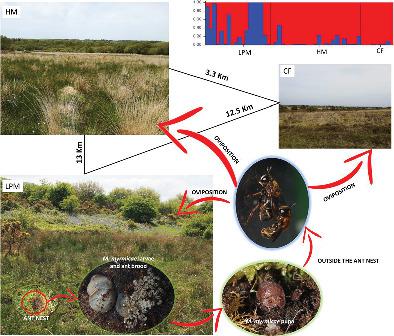当前位置:
X-MOL 学术
›
Ecol. Entomol.
›
论文详情
Our official English website, www.x-mol.net, welcomes your
feedback! (Note: you will need to create a separate account there.)
Social parasite distancing: RADseq reveals high inbreeding in the social parasite Microdon myrmicae but low philopatry for host ant nest
Ecological Entomology ( IF 2.0 ) Pub Date : 2020-10-02 , DOI: 10.1111/een.12944 Giulia Scarparo 1 , Paul Rugman‐Jones 2 , Marco Gebiola 2 , Andrea Di Giulio 1 , Jessica Purcell 2
Ecological Entomology ( IF 2.0 ) Pub Date : 2020-10-02 , DOI: 10.1111/een.12944 Giulia Scarparo 1 , Paul Rugman‐Jones 2 , Marco Gebiola 2 , Andrea Di Giulio 1 , Jessica Purcell 2
Affiliation

|
The hoverfly Microdon myrmicae is a rare and extremely localised social parasite of Myrmica ants, only occurring around wet grassland. Dispersal, location of the host, and oviposition are crucial steps in the life of ant parasites but are poorly known due to the challenge of studying such rare species. Using genome‐wide loci obtained by RADseq, we investigated the genetic structure and relatedness of Mi. myrmicae larvae and its ant host, collected from three localities in South West England, and inferred biological and behavioural traits. We found that: (a) Mi. myrmicae larvae show high inbreeding levels and severe heterozygosity deficiency, as an expression of the small population size that favours the mating between siblings or half‐siblings; (b) Mi. myrmicae adults can disperse for many kilometres, spreading much more than it is reported for its sibling species, Microdon mutabilis; (c) a single female lays small egg bunches in different ant colonies, sometimes spanning substantial distances (bet‐hedging strategy); in parallel, a single ant nest can harbour eggs from different Microdon females; (d) preliminary evidence suggest that contrary to Mi. mutabilis, host colony choice seems not to depend on the number of queens residing in a single colony. These results overall strongly deviate from what previously found for Mi. mutabilis, whose females oviposit in the natal nest generation after generation. We argue that such different ecological traits and parasitic strategies between closely related species are mainly ascribable to the different selective pressure on the two ant hosts.
中文翻译:

社会寄生虫距离:RADseq 揭示社会寄生虫 Microdon myrmicae 的高近亲繁殖,但宿主蚂蚁巢的亲密度低
食蚜蝇 Microdon myrmicae 是一种罕见且极其局限的 Myrmica 蚂蚁社会寄生虫,只发生在潮湿的草原周围。散布、宿主的位置和产卵是蚂蚁寄生虫生命中的关键步骤,但由于研究此类稀有物种的挑战而鲜为人知。使用 RADseq 获得的全基因组位点,我们研究了 Mi 的遗传结构和相关性。myrmicae 幼虫及其蚂蚁宿主,从英格兰西南部的三个地方收集,并推断出生物学和行为特征。我们发现: (a) Mi。myrmicae 幼虫表现出高近交水平和严重的杂合性缺陷,作为有利于兄弟姐妹或半兄弟姐妹之间交配的小种群的表现;(b) 米。myrmicae 成虫可以分散数公里,其兄弟物种 Microdon mutabilis 的传播比报道的要多得多;(c) 单个雌性在不同的蚁群中产小卵串,有时跨越很远的距离(对冲策略);同时,一个蚁巢可以容纳来自不同的 Microdon 雌性的卵;(d) 初步证据表明,与 Mi 相悖。mutabilis,宿主菌落的选择似乎不取决于居住在单个菌落中的蜂后数量。这些结果总体上与之前为 Mi 发现的结果大相径庭。mutabilis,其雌性一代又一代地在出生巢中排卵。我们认为,密切相关物种之间这种不同的生态特征和寄生策略主要归因于对两种蚂蚁宿主的不同选择压力。(c) 单个雌性在不同的蚁群中产小卵串,有时跨越很远的距离(对冲策略);同时,一个蚁巢可以容纳来自不同的 Microdon 雌性的卵;(d) 初步证据表明,与 Mi 相悖。mutabilis,宿主菌落的选择似乎不取决于居住在单个菌落中的蜂后数量。这些结果总体上与之前为 Mi 发现的结果大相径庭。mutabilis,其雌性一代又一代地在出生巢中排卵。我们认为,密切相关物种之间这种不同的生态特征和寄生策略主要归因于对两种蚂蚁宿主的不同选择压力。(c) 单个雌性在不同的蚁群中产小卵串,有时跨越很远的距离(对冲策略);同时,一个蚁巢可以容纳来自不同的 Microdon 雌性的卵;(d) 初步证据表明,与 Mi 相悖。mutabilis,宿主菌落的选择似乎不取决于居住在单个菌落中的蜂后数量。这些结果总体上与之前为 Mi 发现的结果大相径庭。mutabilis,其雌性一代又一代地在出生巢中排卵。我们认为,密切相关物种之间这种不同的生态特征和寄生策略主要归因于对两种蚂蚁宿主的不同选择压力。一个蚁巢可以容纳来自不同雌蚁的卵;(d) 初步证据表明,与 Mi 相悖。mutabilis,宿主菌落的选择似乎不取决于居住在单个菌落中的蜂后数量。这些结果总体上与之前为 Mi 发现的结果大相径庭。mutabilis,其雌性一代又一代地在出生巢中排卵。我们认为,密切相关物种之间这种不同的生态特征和寄生策略主要归因于对两种蚂蚁宿主的不同选择压力。一个蚁巢可以容纳来自不同雌蚁的卵;(d) 初步证据表明,与 Mi 相悖。mutabilis,宿主菌落的选择似乎不取决于居住在单个菌落中的蜂后数量。这些结果总体上与之前为 Mi 发现的结果大相径庭。mutabilis,其雌性一代又一代地在出生巢中排卵。我们认为,密切相关物种之间这种不同的生态特征和寄生策略主要归因于对两种蚂蚁宿主的不同选择压力。其雌性在出生巢中一代又一代地排卵。我们认为,密切相关物种之间这种不同的生态特征和寄生策略主要归因于对两种蚂蚁宿主的不同选择压力。其雌性在出生巢中一代又一代地排卵。我们认为,密切相关物种之间这种不同的生态特征和寄生策略主要归因于对两种蚂蚁宿主的不同选择压力。
更新日期:2020-10-02
中文翻译:

社会寄生虫距离:RADseq 揭示社会寄生虫 Microdon myrmicae 的高近亲繁殖,但宿主蚂蚁巢的亲密度低
食蚜蝇 Microdon myrmicae 是一种罕见且极其局限的 Myrmica 蚂蚁社会寄生虫,只发生在潮湿的草原周围。散布、宿主的位置和产卵是蚂蚁寄生虫生命中的关键步骤,但由于研究此类稀有物种的挑战而鲜为人知。使用 RADseq 获得的全基因组位点,我们研究了 Mi 的遗传结构和相关性。myrmicae 幼虫及其蚂蚁宿主,从英格兰西南部的三个地方收集,并推断出生物学和行为特征。我们发现: (a) Mi。myrmicae 幼虫表现出高近交水平和严重的杂合性缺陷,作为有利于兄弟姐妹或半兄弟姐妹之间交配的小种群的表现;(b) 米。myrmicae 成虫可以分散数公里,其兄弟物种 Microdon mutabilis 的传播比报道的要多得多;(c) 单个雌性在不同的蚁群中产小卵串,有时跨越很远的距离(对冲策略);同时,一个蚁巢可以容纳来自不同的 Microdon 雌性的卵;(d) 初步证据表明,与 Mi 相悖。mutabilis,宿主菌落的选择似乎不取决于居住在单个菌落中的蜂后数量。这些结果总体上与之前为 Mi 发现的结果大相径庭。mutabilis,其雌性一代又一代地在出生巢中排卵。我们认为,密切相关物种之间这种不同的生态特征和寄生策略主要归因于对两种蚂蚁宿主的不同选择压力。(c) 单个雌性在不同的蚁群中产小卵串,有时跨越很远的距离(对冲策略);同时,一个蚁巢可以容纳来自不同的 Microdon 雌性的卵;(d) 初步证据表明,与 Mi 相悖。mutabilis,宿主菌落的选择似乎不取决于居住在单个菌落中的蜂后数量。这些结果总体上与之前为 Mi 发现的结果大相径庭。mutabilis,其雌性一代又一代地在出生巢中排卵。我们认为,密切相关物种之间这种不同的生态特征和寄生策略主要归因于对两种蚂蚁宿主的不同选择压力。(c) 单个雌性在不同的蚁群中产小卵串,有时跨越很远的距离(对冲策略);同时,一个蚁巢可以容纳来自不同的 Microdon 雌性的卵;(d) 初步证据表明,与 Mi 相悖。mutabilis,宿主菌落的选择似乎不取决于居住在单个菌落中的蜂后数量。这些结果总体上与之前为 Mi 发现的结果大相径庭。mutabilis,其雌性一代又一代地在出生巢中排卵。我们认为,密切相关物种之间这种不同的生态特征和寄生策略主要归因于对两种蚂蚁宿主的不同选择压力。一个蚁巢可以容纳来自不同雌蚁的卵;(d) 初步证据表明,与 Mi 相悖。mutabilis,宿主菌落的选择似乎不取决于居住在单个菌落中的蜂后数量。这些结果总体上与之前为 Mi 发现的结果大相径庭。mutabilis,其雌性一代又一代地在出生巢中排卵。我们认为,密切相关物种之间这种不同的生态特征和寄生策略主要归因于对两种蚂蚁宿主的不同选择压力。一个蚁巢可以容纳来自不同雌蚁的卵;(d) 初步证据表明,与 Mi 相悖。mutabilis,宿主菌落的选择似乎不取决于居住在单个菌落中的蜂后数量。这些结果总体上与之前为 Mi 发现的结果大相径庭。mutabilis,其雌性一代又一代地在出生巢中排卵。我们认为,密切相关物种之间这种不同的生态特征和寄生策略主要归因于对两种蚂蚁宿主的不同选择压力。其雌性在出生巢中一代又一代地排卵。我们认为,密切相关物种之间这种不同的生态特征和寄生策略主要归因于对两种蚂蚁宿主的不同选择压力。其雌性在出生巢中一代又一代地排卵。我们认为,密切相关物种之间这种不同的生态特征和寄生策略主要归因于对两种蚂蚁宿主的不同选择压力。











































 京公网安备 11010802027423号
京公网安备 11010802027423号